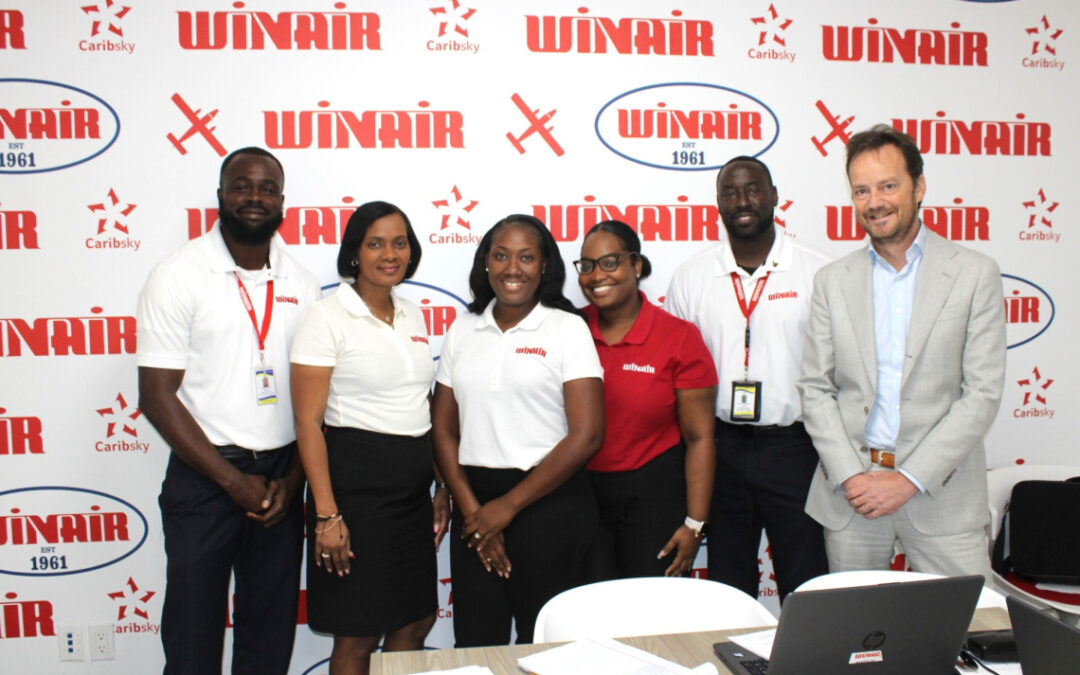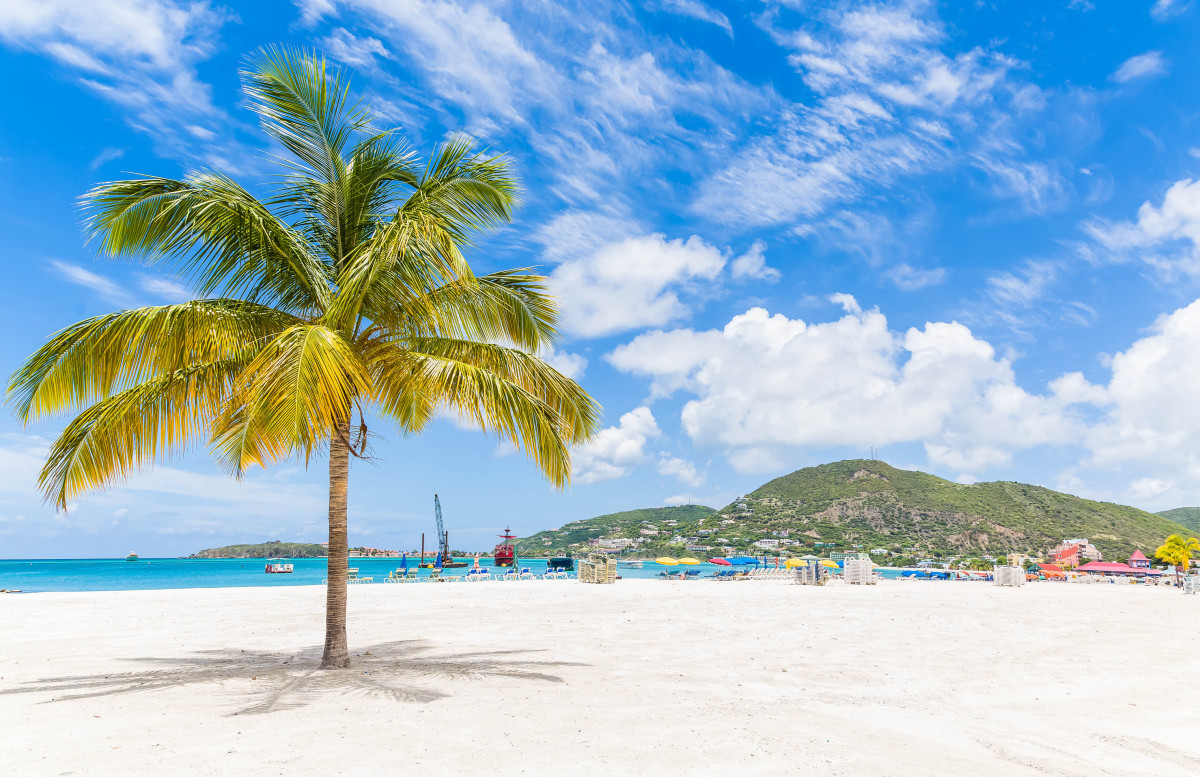Picture caption: Winair CEO Hans van de Velde (right) with five of the airline’s dedicated employees working towards achieving IOSA certification.
By Jacqueline Hooftman
SIMPSON BAY– In the office of Windward Islands Airways International N.V. (Winair) on Airport Road, dedicated staff members are diligently striving to ensure compliance with rigorous international aviation safety standards. Last Friday, a team of five proceeded with an exhaustive review of Winair’s manuals, meticulously scrutinising each paragraph with the aim of identifying necessary amendments and additions essential for the attainment of IOSA certification for the government-owned St. Maarten-based airline.
IOSA, shorthand for IATA Operational Safety Audit, is a globally recognised evaluation system established by the International Air Transport Association (IATA) to meticulously assess operational safety and related controls.
The IOSA online register lists KLM-Air France, American Airlines, Jet Blue and other large and medium-size airlines that have St. Maarten as their destination. Only two airlines in the Caribbean are IOSA certified: French Air Caraibes from Guadeloupe, and Trinidadian Caribbean Airlines, whose registration is currently provisional due to interim corrective actions.
On February 2, 15 Winair employees embarked on the training necessary to start the IOSA certification process. “Our aviation operations are currently 95% compliant,” says Winair’s Chief Executive Officer (CEO) Hans van de Velde, referencing the regulations of the local St. Maarten aviation authorities. “IOSA is very strict, we must meet their requirements 100%. We will achieve that in the course of 2025.”
Van de Velde, formerly the managing director of TUI France and TUI Maroc, assumed the position of CEO at Winair in July 2023, succeeding Michael Cleaver, who retired after 12 years of dedicated leadership at the airline. TUI (Tourism Union International) stands as a pillar in the global tourism platform sector, with the TUI Group showcasing an impressive array of assets. This includes more than 400 owned hotels, a fleet of 16 cruise ships, five airlines equipped with approximately 130 aircraft, and a network of 1,200 travel agencies offering destination services spanning all major holiday destinations worldwide.
Notably, Van de Velde contributed his expertise to the TUI Group for 18 years, underscoring his seasoned leadership in the industry.
Van de Velde welcomed a reporter from “The Daily Herald” (TDH) into his office on Friday morning. During the meeting, he shared insights into his vision for Winair’s future. Notably, Winair currently boasts 10 interline agreements, facilitating seamless passenger coordination across multiple airlines. This service allows travellers to navigate their itinerary without the hassle of additional check-ins or baggage-handling during stopovers.
Van de Velde revealed plans to expand Winair’s network by adding two new airline partners in the near future. Furthermore, he hinted at an upcoming announcement unveiling two new destinations, demonstrating Winair’s commitment to enhancing connectivity across the Caribbean region.
TDH: What made you want to become the new CEO of Winair?
Van de Velde: I thrive on strategic planning and operational intricacies; it’s where I excel. In the context of a small Caribbean airline like Winair, collaboration with other airlines is paramount. It’s a stark contrast to TUI’s operations, which primarily focus on transporting holidaymakers directly to destinations managed by the TUI Group. Unlike TUI, Winair’s survival hinges on forging partnerships with other airlines, ensuring a steady and sustainable operation.
TDH: You have arrived at a time when Winair is doing well; in 2023, the airline acquired its first two ATR 42-500 aircraft and successfully repaid the loan provided by the Dutch government to navigate through the challenges posed by the pandemic.
Van de Velde: Interestingly, the decision to invest in two ATRs came at an opportune time. Winair had been collaborating with Air Antilles, utilising their aircraft, but unfortunately, during the week I arrived, Air Antilles declared bankruptcy. While the collaboration was destined to conclude after five years, the bankruptcy accelerated the process.
LIAT [Leeward Islands Air Transport Services – Ed.] also ceased operations. While both Air Antilles and LIAT are expected to make a restart in the near future, their current absence from the market presents opportunities for Winair.
TDH: Winair was able to take over routes from Air Antilles?
Van de Velde: It is not that simple. Aviation regulations in this region are of a highly protectionist nature. While Dutch airlines like Winair are permitted to fly to French islands such as St. Barths and Guadeloupe, restrictions prevent us from operating flights between these islands. Similarly, French airlines face limitations, such as the inability to fly from St. Maarten to Saba or St. Eustatius.
TDH: After the bankruptcy of Air Antilles, haven’t the French islands wanted to charter aircraft from Winair?
Van de Velde: We did receive a request from parties in St. Barths. Following the cessation of Air Antilles’ operations, there is limited connections between St. Barths and Guadeloupe. Asked to fill this gap, we submitted a request to the French government for permission to operate on this route as an exception, with the commitment to cease operations once a successor to Air Antilles emerged. Despite this, Winair received a letter after a few days stating that the request was denied.
TDH: In the fall of 2021, Makana Ferry Service commenced its voyages connecting St. Maarten, Saba, St. Eustatius, and St. Kitts, while also establishing a partnership with the ferry service to St. Barths. Does Winair perceive this as competition?
Van de Velde: Certainly, although there is a market for both ferry and airline transportation. The ferry option not only offers lower cost but also has the capacity to accommodate significantly more passengers compared to our 19-passenger DHC-6 Twin Otters that operate between the islands. In response to this, Winair recently introduced day fares two weeks ago, providing round-trip flights to Saba, Statia, and St. Barths within a single day. The pricing is relatively affordable, as part of our collaboration with Princess Juliana Airport on a six-month project aimed at assessing the viability of reducing round-trip tariffs to US $79.99.
Our objective is to enhance the attractiveness of these routes to both local customers and tourists.
TDH: Flights between the islands are relatively expensive, if you compare it with international flights.
Van de Velde: This pricing challenge stems from our operations’ small scale. With relatively low passenger numbers per flight and high costs associated with aircraft, ticket prices are inevitably driven up. Although our ATRs can accommodate 50 passengers, we often see only around 35 seats filled per flight. It’s frustrating to have to charge customers a comparatively high fare for such a short journey. For example, if we had a consistent flow of 200 passengers travelling to Curaçao daily, ticket prices could be significantly lower. However, the demand from travellers simply isn’t at that level.”
TDH: Hence the desire to collaborate with other major airlines?
Van de Velde: Yes, we currently utilise interlining, where each partner is accountable for their specific route. For instance, our flight to St. Barths seamlessly connects with Air France flights from Paris, providing passengers with prior knowledge that Winair will transport them to St. Barths.
However, we aim to progress further by implementing code sharing. Last year, I noted KLM-AirFrance’s decision to suspend flights to Barbados. Winair could efficiently operate these flights using our ATRs from St. Maarten. Yet, any collaboration requires Winair to obtain IOSA certification according to KLM’s standards. With code-sharing, Winair would conduct the flight under the KLM-Air France flight code, assuming responsibility for the entire route.
Whether KLM-Air France perceives it as commercially viable to maintain sales of Barbados flights remains uncertain. Nonetheless, without IOSA certification, this partnership would not proceed.”
TDH: Does that also mean investing in new aircraft?
Van de Velde: Winair currently operates with two ATRs, which suffice for the present. However, to establish a sustainable long-term operation, we aim to expand our fleet to four or five of these aircraft.
TDH: According to Dutch Minister of Infrastructure and Water Management Mark Harbers, commercial passenger flights between Aruba, Bonaire and Curaçao with electric aircraft can start in 2026. Harbers is adamant that it is feasible to operate 100% of the flights between the Lower and Windward Islands with electric aircraft by 2035.
Van de Velde: That’s a complete misconception. While developments in aviation are progressing rapidly, they’re not instantaneous. New aircraft are very expensive, and the nature of the operation in this region does not permit airlines to just go off and buy new electric aircraft, since who would furnish us the money to do that? A few months ago, during an aviation conference in Curaçao, I extended invitations to representatives of electric aircraft manufacturers, urging them to offer models at a cost comparable to our current fleet and with equivalent performance capabilities.
However, one crucial aspect is often overlooked: Winair operates on a tight schedule, with planes taking off for the next destination just 15 minutes after landing. Requiring electric charging at each stop would significantly extend turnaround times and reduce flying hours, ultimately driving up cost.
If electric aircraft manufacturers can assure us that their planes offer identical operational performance and costs compared to our current fleet, then we’re absolutely open to adopting them. In fact, we’d be willing to invest even if the upfront costs are slightly higher. The routes between the islands are ideally suited for such operations.
TDH: The willingness is there, but the year 2035 is much too soon?
Van de Velde: We need to be realistic about the timeline for transitioning to electric aircraft. While the technology shows promise, there are still significant hurdles to overcome, including infrastructure development, regulatory frameworks, and cost considerations. Setting an ambitious yet achievable target is essential for the successful implementation of electric aviation in our region.
Source: The daily Herald


